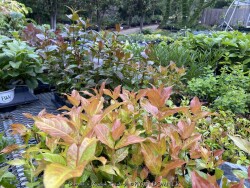

Looking for a durable native plant that will thrive in sun or shade, and is drought-tolerant? Deer-resistant, too? You've got it! This shrub (Diervilla x 'Kodiak Fresh') gives a new look to Diervilla with its bright lime-yellow foliage in summertime, always accompanied by bright yellow flowers. Like the other members of the Kodiak series, it lights up the fall landscape, making it an eco-friendly alternative to burning bush. A durable native plant that thrives in sun or shade, it is drought-tolerant, deer-resistant, and can even grow in dry shade. This is an excellent landscape plant that will succeed in even challenging sites. Top three reasons to grow Kodiak® Fresh diervilla: 1.Tolerant of dry shade (though color is best with at least some sun) 2.Never without yellow flower clusters in the summer. 3.Orangey-red new growth, persistent lime coloring, and glowing orange fall foliage. Uses Notes: Naturalizing; mass plantings. Maintenance Notes: Adaptable to most soils, including dry ones. Trim in spring and apply a controlled-release fertilizer. Though it is sometimes called "bush honeysuckle," Diervilla is not invasive like certain honeysuckles are. In Eastern Kansas, this cultivar performs WELL with just about everything nature has to challenge it! Heat and drought are tolerated if in shade or morning sun. Cold tolerance is no problem. No disease or pest problems. Great plant for dry-shade. Native to North America. All Proven Winners® plants are legally propagated, healthy and vigorous, true to name, and tagged with color pictures and growing information.
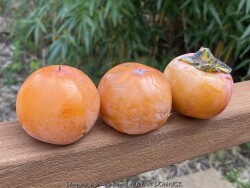

Yates Persimmon Tree (Fruiting Cultivar), is also known as Diospyros virginiana 'Yates'. >>>>> According to Starks Bros "A sweet native of Indiana. This fast-growing variety is pest- and disease-resistant. When fruit is soft and completely mature, it features a sweet, apricot-like flavor. Cold-hardy and heat-tolerant. Tree reaches 35-50' tall. Ripens in early September. Grafted. Self-pollinating. In Fall, enjoy harvesting large, orange, flavorful fruit with no black spots. Cross-pollination by a different variety is key to its growing and bearing success. Almost all American persimmon trees require a pollinator to bear fruit except 'Meader' and 'Yates'. Persimmons ripen in October to November with bright orange fruit. The fruit softens and sweetens once they experience frost. In many cases, you may still want to plant pollinating partners to increase the size of your crops, but with self-pollinating varieties doing so is optional. You'll get fruit with only one plant."
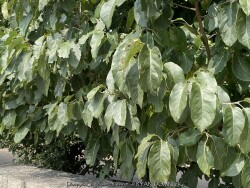

Yates Persimmon Tree (Fruiting Cultivar), is also known as Diospyros virginiana 'Yates'. >>>>> According to Starks Bros "A sweet native of Indiana. This fast-growing variety is pest- and disease-resistant. When fruit is soft and completely mature, it features a sweet, apricot-like flavor. Cold-hardy and heat-tolerant. Tree reaches 35-50' tall. Ripens in early September. Grafted. Self-pollinating. In Fall, enjoy harvesting large, orange, flavorful fruit with no black spots. Cross-pollination by a different variety is key to its growing and bearing success. Almost all American persimmon trees require a pollinator to bear fruit except 'Meader' and 'Yates'. Persimmons ripen in October to November with bright orange fruit. The fruit softens and sweetens once they experience frost. In many cases, you may still want to plant pollinating partners to increase the size of your crops, but with self-pollinating varieties doing so is optional. You'll get fruit with only one plant."
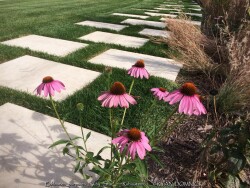

>>>>>Echinacea purpurea is an herbaceous perennial native to parts of eastern and midwestern United States most common in Missouri and Arkansas. Its habitats include dry open woods, prairies and barrens. Echinacea are native to North America, featuring sunflower-like flowers with a dark center and colorful petals. Colors on native plants include purple, magenta, white, yellow. Intensive breeding efforts to fish out recessive genes have brought bright orange and red into the picture. Flowers occur in early to mid summer often continuing into fall especially if dead-headed. Its individual flowers (florets) within the flower head are two-toned, having both male and female organs in each flower. (hermaphroditic) Bees and butterflies including the monarch are common pollinators. The dead flowers are attractive to some for winter interest but for those wanting a tidy your garden, they can be trimmed early. Leaving some dried seed heads will be beneficial for wildlife and provide winter food for finches and other birds. Best growth generally occurs in full to part sun with well drained soils with low to average moisture. In Eastern Kansas, typically our 40 inches of rainfall is sufficient without extra water. Coneflower can also handle short one to two day flooding events and are sometimes used along the higher perimeter of rain gardens to bring in pollinators. Coneflower mixes well with many other types of plants ranging from other native plants to evergreens to hardy tropicals. Rabbits can be a problem young immature plants. A popular method of control is covering the plant with an upside down bowl-shaped chicken wire cage for the first year to allow basil foliage to establish well. You can quickly make these yourself with a low cost roll of chicken wire. Mature plants especially in groups with other mature landscaping generally do not have rabbit problems. Flowers are also popular in the florist industry as cut flowers or in the cottage garden. The genus echinacea has undergone intense breeding with the introduction of hundreds of new cultivars in the last 10 years. Sunset Coneflower / Red-Orange Coneflower (Echinacea x Sunset) features red-orange and pinkish flowers. Most orange or red types if allowed to self-seed will produce purple flowering plants.
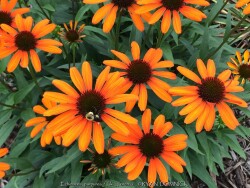

Echinacea purpurea is an herbaceous perennial native to parts of eastern and midwestern United States most common in Missouri and Arkansas. Its habitats include dry open woods, prairies and barrens. Echinacea are native to North America, featuring sunflower-like flowers with a dark center and colorful petals. Colors on native plants include purple, magenta, white, yellow. Intensive breeding efforts to fish out recessive genes have brought bright orange and red into the picture. Flowers occur in early to mid summer often continuing into fall especially if dead-headed. Its individual flowers (florets) within the flower head are two-toned, having both male and female organs in each flower. (hermaphroditic) Bees and butterflies including the monarch are common pollinators. The dead flowers are attractive to some for winter interest but for those wanting a tidy your garden, they can be trimmed early. Leaving some dried seed heads will be beneficial for wildlife and provide winter food for finches and other birds. Best growth generally occurs in full to part sun with well drained soils with low to average moisture. In Eastern Kansas, typically our 40 inches of rainfall is sufficient without extra water. Coneflower can also handle short one to two day flooding events and are sometimes used along the higher perimeter of rain gardens to bring in pollinators. Coneflower mixes well with many other types of plants ranging from other native plants to evergreens to hardy tropicals. Rabbits can be a problem young immature plants. A popular method of control is covering the plant with an upside down bowl-shaped chicken wire cage for the first year to allow basil foliage to establish well. You can quickly make these yourself with a low cost roll of chicken wire. Mature plants especially in groups with other mature landscaping generally do not have rabbit problems. Flowers are also popular in the florist industry as cut flowers or in the cottage garden. The genus echinacea has undergone intense breeding with the introduction of hundreds of new cultivars in the last 10 years. Several cultivars featuring the break-thru orange color. Older varieties were less vigorous but new varieties are much improved. Most orange or red types if allowed to self-seed will produce purple flowering plants.


Barrenwort (Epimedium) features compact dainty mounds of green to colored weed-resistant foliage. Wispy flowers appear above emerging foliage in mid-spring. Improved breeding has resulted in many different flower colors even including orange. Semi-evergreen foliage can sometimes look bedraggled by late summer if there is too much overhead watering and humidity. Barrenwort prefers average to dry garden conditions and even thrive and dry shade. Plantings can thrive for decades if in the right spot; there is no such thing as overcrowding for Barrenwort. When planted in mass, growth is slow at first but eventually a cake-like rhizome system will form and completely smother out any weeds and compete well with trees for water and nutrients. While barrenwort can tolerate full sun, they prefer part to full shade. Sun burning is possible with temperatures over 100° and there are better plants to use in hot areas. Due to slow spreading growth, you shouldn't leave very much room in-between barrenwort plants or you will be waiting many years for the patch to fill in. Weeds can be a problem in that open area between plants if spacing is too wide. We recommend 9-12" spacing and use for small nooks in the shade garden. If planning for a larger area, still figure on the tight spacing but allow for a higher budget that you will consider a permanent investment. Barrenwort is a real trooper for the dry shade garden!
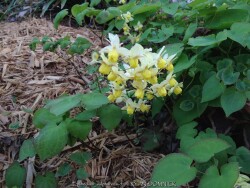

Barrenwort (Epimedium) features compact dainty mounds of green to colored weed-resistant foliage. Wispy flowers appear above emerging foliage in mid-spring. Improved breeding has resulted in many different flower colors even including orange. Semi-evergreen foliage can sometimes look bedraggled by late summer if there is too much overhead watering and humidity. Barrenwort prefers average to dry garden conditions and even thrive and dry shade. Plantings can thrive for decades if in the right spot; there is no such thing as overcrowding for Barrenwort. When planted in mass, growth is slow at first but eventually a cake-like rhizome system will form and completely smother out any weeds and compete well with trees for water and nutrients. While barrenwort can tolerate full sun, they prefer part to full shade. Sun burning is possible with temperatures over 100° and there are better plants to use in hot areas. Due to slow spreading growth, you shouldn't leave very much room in-between barrenwort plants or you will be waiting many years for the patch to fill in. Weeds can be a problem in that open area between plants if spacing is too wide. We recommend 9-12" spacing and use for small nooks in the shade garden. If planning for a larger area, still figure on the tight spacing but allow for a higher budget that you will consider a permanent investment. Barrenwort is a real trooper for the dry shade garden! Epimedium x versicolor 'Sulphureum' is a faster spreading, more robust yellow flowering variety. Albeit still very slow compared to other perennials.
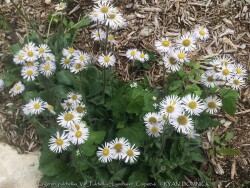

Robin's Plantain / Fleabane, is also known as Erigeron pulchellus var. pulchellus 'Lynnhaven Carpet'
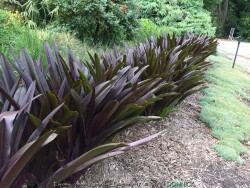

Sparkling Burgundy Pineapple Lily (Eucomis comosa 'Sparkling Burgundy') are typically grown for their wide tropical foliage and pineapple-like flowers. Deep purple foliage contrasts well with many other flower colors. The plants are temperate and subtropical herbaceous perennial bulbs native to areas with a summer wet season and dry winter. Pineapple Lily are hardy outside as a perennial when established and with minimal effort at least up to zone 6a. During the growing season, fertilize, water regularly, and plant in full sun. Plant these bulbs in the ground at least 6-8" deep with 3-4" of mulch to enjoy a wonderful tropical effect! Foliage may look bedwraggled by fall so it is ok to cut back foliage at that time. They can also be grown as a flowering summer patio plant. If growing as a potted plant and trying to overwinter, allowing the foliage to frost is ok, it will not kill the root system. However, do not allow the pot with rootball to freeze solid or go below 20 degrees for more than a few hours; move into a cold garage or basement over the winter with no watering. Cut back and allow to go dormant and place entire pot back out in April or May with a time-release fertilizer. Another more labor intensive way to overwinter pineapple lily is to remove them from the dirt, dust with fungicide, place in box with sawdust, and keep in the refrigerator. We consider this method old-fashioned and too much work but ok if you only want to save a few bulbs. If digging from the ground in colder zones, just save a big chunk with the dirt intact and place into a large pot in the garage. In our display garden in Lawrence, KS (zone 6a), an established specimen planted over 4-6" deep and mulched 2-3" with wood mulch survived -17 degrees F. During the arctic blast of February, 2021, lows down to -17 degrees F on Feb 16th, 2021 were recorded. The longevity of this cold blast was also impressive: 10 days on a row with highs of 10-15 degrees F or lower, 8 nights of lows in the single digits and negatives, and 36 straight hours of 0 degrees F and mostly lower. This eucomis has survived for over 10 years and other extreme cold blasts in the past.
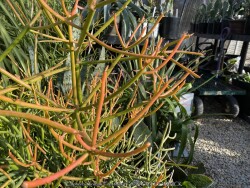

The Pencil Cactus (Euphorbia tirucalli) is a shrub with pencil-thick, green, smooth, succulent branches that provide photosynthesizes long after the foliage is shed. Usually grown as a patio or house plant in Kansas. Grow in full sun to full shade with optional extra watering including that which comes from rainfall. Plants with time to acclimate will thrive in full sun but be careful not to rush it or sunburning will occur. Generally if moving outside for the summer, allow 2-3 weeks of part shade or morning sun before placing in full sun. Repotting may or may not be needed depending on how large you want the plant to grow; plants can continue to grow taller and tolerate extremely root-bound pots but may need wind bracing. Potted plants are hardy to at least 25 degrees F for a short time if kept dry so you are ok if you miss the first light frost. Do not allow the pot with rootball to freeze solid though. Then move into a cold garage, basement, or bright window over the winter with occasional watering. As a winter house plant, it will look presentable all winter long with just a few waterings. As a permanent house plant, provide bright light and allow the soil to dry between waterings for many years of carefree enjoyment. Potted plants are very low maintenance needing very occasional pruning or topping. Stems are filled with a toxic milky sap which seems to flow out very vigorously even with only the tiniest injury. All members of the genus Euphorbia produce a milky sap called latex that is toxic and can range from a mild irritant to very poisonous. Firesticks Pencil Cactus (Euphorbia tirucalli 'Firesticks') is a highly ornamental variety that is more of a chartreuse color with bright orange and red tips developing in response to cold night temperatures.
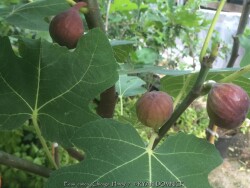

The common fig (Ficus carica) is native to an area extending from Asiatic Turkey to northern India. In Kansas, plant in a protected area near the house on south or west side but will survive in other locations in full hot sun. As an edible, ornamental plant, figs are an attractive bush-like plant with sandpapery green sometimes deeply lobed leaves. There is a slight and pleasant aroma when brushing against the foliage. Fruits are dark purple to maroon. Figs love full hot sun and are very drought tolerant but will produce more fruit if watered during the summer. Expect fig tree to die to the ground each year and start growing in May a bit later than other plants. Regrowth is rapid and established figs will have dozens of 5-6' water sprouts loaded with a few hundred fruits by September. You will always get a late summer/fall crop because fruit can come from new wood. If growing as a potted patio plant, grow in full sun with plenty of water during the summer. Then in late fall before temperatures get below 20 degrees F, move into a cold garage or basement over the winter with minimal watering. Do not allow the pot with rootball to freeze solid or go below 15 degrees for more than a few hours. By March or April, the fig will be trying to grow and you may put back outside (protect from late frosts) and you will also have a spring fruit crop. Eat fresh, freeze for fruit smoothies, or dry in sun or food dehydrator. In our trial gardens in Lawrence, KS (zone 6a), several established specimens planted 5-10 years ago and mulched 1-3" with wood mulch survived -17 degrees F. During the arctic blast of February, 2021, lows down to -17 degrees F on Feb 16th, 2021 were recorded. The longevity of this cold blast was also impressive: 10 days on a row with highs of 10-15 degrees F or lower, 8 nights of lows in the single digits and negatives, and 36 straight hours of 0 degrees F and mostly lower. 'Chicago Hardy' is considered to be one of the hardiest edible figs producing reliable fruits. It's stems are hardy to 10°F and the roots are hardy to -20°F. Sometimes if prolonged September cold-fronts occur and temperatures are too low at night, green fruits will disappointingly stop ripening. Look for a hot planting location microclimate such as a West or South wall to encourage fruit to ripen. Ripening does not continue to progress if harvested early (when fruit has any green coloring present).
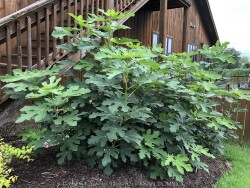

The common fig (Ficus carica) is native to an area extending from Asiatic Turkey to northern India. In Kansas, plant in a protected area near the house on south or west side but will survive in other locations in full hot sun. As an edible, ornamental plant, figs are an attractive bush-like plant with sandpapery green sometimes deeply lobed leaves. There is a slight and pleasant aroma when brushing against the foliage. Fruits are dark purple to maroon. Figs love full hot sun and are very drought tolerant but will produce more fruit if watered during the summer. Expect fig tree to die to the ground each year and start growing in May a bit later than other plants. Regrowth is rapid and established figs will have dozens of 5-6' water sprouts loaded with a few hundred fruits by September. You will always get a late summer/fall crop because fruit can come from new wood. If growing as a potted patio plant, grow in full sun with plenty of water during the summer. Then in late fall before temperatures get below 20 degrees F, move into a cold garage or basement over the winter with minimal watering. Do not allow the pot with rootball to freeze solid or go below 15 degrees for more than a few hours. By March or April, the fig will be trying to grow and you may put back outside (protect from late frosts) and you will also have a spring fruit crop. Eat fresh, freeze for fruit smoothies, or dry in sun or food dehydrator. In our trial gardens in Lawrence, KS (zone 6a), several established specimens planted 5-10 years ago and mulched 1-3" with wood mulch survived -17 degrees F. During the arctic blast of February, 2021, lows down to -17 degrees F on Feb 16th, 2021 were recorded. The longevity of this cold blast was also impressive: 10 days on a row with highs of 10-15 degrees F or lower, 8 nights of lows in the single digits and negatives, and 36 straight hours of 0 degrees F and mostly lower. 'Chicago Hardy' is considered to be one of the hardiest edible figs producing reliable fruits. It's stems are hardy to 10°F and the roots are hardy to -20°F. Sometimes if prolonged September cold-fronts occur and temperatures are too low at night, green fruits will disappointingly stop ripening. Look for a hot planting location microclimate such as a West or South wall to encourage fruit to ripen. Ripening does not continue to progress if harvested early (when fruit has any green coloring present).
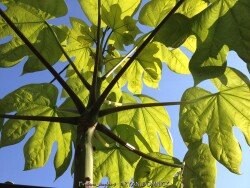

Chinese Parasol Tree (Firmiana simplex) is typically grown as a hardy tropical with huge green leaves and bright green stems that last through winter. This "die to the ground each winter" tree is even more impressive from water strout shoots from the ground. When grown in Kansas, it can be used as summer patio plant tolerating root-boundness well. Water regularly and place in full sun or part shade and enjoy all summer long into late fall. Potted plants are hardy to at least 25 degrees F for a short time if kept dry so you can wait awhile to move these in for the winter. Do not allow the pot with rootball to freeze solid though. Move into a cold garage or basement over the winter. Provide minimal watering and allow the foliage to go dormant and drop off if not already. Bright green stems will remain and add interest during winter. Place back out in April or May with a time-release fertilizer. Landscapers mainly plant Chinese Parasol "Tree" as a die-back to the ground woody perennial "tree". Even without mulch, it is easy to overwinter Firmiana simplex in the ground in Kansas as a woody perennial; complete die-back happens every 1-2 years. The resulting water sprouts from the ground create a bold tropical effect with robust bright green shoots resembling pool cue sticks reaching 5-8' in one season from a 3gal container! We have measured leaves up to 36" long aranded in whorls along the stems. Plants can exceed 15 feet with two consecutive years with no die-back when planted on a South wall. In Eastern Kansas, typically our 40 inches of rainfall is sufficient without extra water in good soils. Chinese Parasol Tree has been planted in our trial gardens and at several residential gardens in Lawrence, KS (zone 6a) 5-10 years ago. During the arctic blast of February, 2021, lows down to -17 degrees F on Feb 16th, 2021 were recorded. The longevity of this cold blast was also impressive: 10 days on a row with highs of 10-15 degrees F or lower, 8 nights of lows in the single digits and negatives, and 36 straight hours of 0 degrees F and mostly lower. Most plants survived with complete die-back and new spring water sprouts. This species is an aggressive, invasive weed in the warmer parts of North America south of zone 7b but not in Kansas because seeds never have a chance to form. Taking 5-7 years to reach flowering size, die-back is much more frequent than that in zone 6. Wow, what a "releaf"!
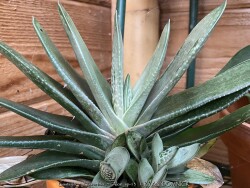

These succulents are usually spineless and grown for their beautiful shapes, color and texture. Gasteria / Haworthia / Aloe are usually grown as small patio or house plants in Kansas. In the wild, some species are hardy to below 20 degrees F. Grow in part sun to full shade with little extra watering except that which comes from rainfall. Repotting may or may not be needed depending on how large you want the plant to grow; plants can continue to grow and tolerate extremely root-bound pots but will eventually need thinned or repotted. If repotting, make sure to use a sharp draining low organic cactus mix with plenty of sand and perlite. To play is safe, potted plants are best moved in before night temperatures get below 45 degrees F. It is important to avoid the combination of wet and cold. Move to a bright interior window over the winter with no watering and keep above freezing. As a winter house plant, it will look presentable all winter long with just a few waterings. As a permanent house plant, provide bright light and allow the soil to dry between waterings for many years of carefree enjoyment. Generally if moving outside for the summer, keep in part to full shade. Some species will acclimate and thrive in full sun but be careful not to rush it or sunburning will occur; move into sun gradually over a few weeks. Potted plants are very low maintenance but avoid too much water or plants will rot.
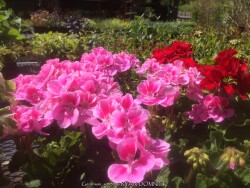

***Description for this plant available with future update!***
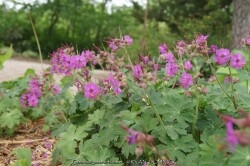

Geranium macrorrhizum, commonly called Bigroot Geranium is native to the Southeast Alps and the Balkans. It features highly aromatic fuzzy leaves that leave you wanting another sniff after crushing a leaf in your hand. Early summer pink, rose, or white flowers form depending on the cultivar. It forms a weed-suppressing mat of rhizomatous semi-evergreen perennial that typically grows to 12" tall but spreads to 24" wide. Root rot can be a problem in poor drainage areas. Bigroot Geranium is the most drought tolerant of the hardy geraniums earning a spot in the dry shade garden; it cannot handle extreme drought or extremely rootbound soils though. It prefers average to dry garden conditions with dappled or morning sun. Sun burning is possible with temperatures over 100° so avoid full afternoon sun. Plantings can thrive for decades if in the right spot as there is no such thing as overcrowding for Big Root Geranium. When planted in mass, growth is slow at first but eventually a cake-like rhizome system will form and completely smother out any weeds and compete well with trees for water and nutrients. The growth rate is slow at first so space new plants relatively close together is desiring this effect.
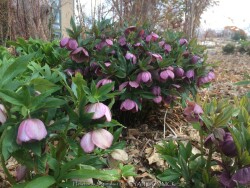

Lenten Rose (Helleborus) is the ultimate dry-shade plant for eastern Kansas landscapes. Most hellebores are native to mountainous wooded regions of Europe with limestone bedrock and calcareous, humus-rich soils. They have everything a gardener might ask for; beautiful spring flowers, dependable dark green foliage, evergreen during winter, appreciation for alkaline soils, and ease of care with very low maintenance. Hellebores are one of the first perennials to start growing in the spring with flowering occurring even with hard freezes. Flowers last incredibly long 2 to 3 months and finally turn greenish in June. No deadheading is needed because the foliage just absorbs the flower stalks as they fade. Summer and fall foliage is dark green, dependable, and pest-free. Evergreen foliage is hardy to about 0°F. If it gets colder than that, hellebores will be deciduous with no detrimental effects. Desirable self-seeding may gently occur around mother plants. Hellebores do have an Achilles heel however; they cannot tolerate wet or poorly drained soils, not even slightly. In areas with too much rainfall or poorly drained soils, foliage diseases and root rot are likely to occur. Hellebores are also not the best choice for full sun, while they will survive, they will get foliage burn in the summer when over 100°F in afternoon sun. With poisonous foliage, these plants resist deer and rabbit browsing. What a great plant for the dry shade garden! There are many improved flowering cultivars to choose from now.
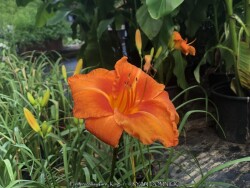

Fire King Orange Daylily, is also known as Hemerocallis 'Fire King'


Red Razzmatazz Daylily, is also known as Hemerocallis 'Red Razzmatazz'


Ruby Spider Daylily, is also known as Hemerocallis 'Ruby Spider'
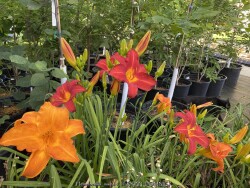

Daylily (Mixed Colors), is also known as Hemerocallis cultivars
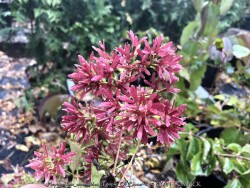

Hang on to your hat - Temple of Bloom® Seven-Son Flower (Heptacodium miconioides 'Temple Of Bloom') is going to blow your mind! We are thrilled to be able to bring this outstanding plant, previously known only by collectors and plant geeks, to everyone in North America. Temple of Bloom seven-son flower is a beautiful, easy to grow small tree which simply can't be matched for year-round beauty. In spring, the handsome leaves emerge, each sporting dramatically deep veins that make the plant stand out in the landscape. As the season progresses, the leaves grow larger and develop a long, twisting tip. Come August, when everything else is winding down, Temple of Bloom seven-son flower is just coming into its own, as it becomes covered in big clusters of fragrant white flowers that hummingbirds and other pollinators flock to. They last for weeks before gracefully falling to the ground to reveal vivid red, fan-like bracts, which make it look like the plant is blooming again in a completely different color. As winter comes and the leaves drop, the plant's elegant frame is revealed, along with amazing light tan peeling bark. Temple of Bloom® seven-son flower is the perfect choice for a special spot in your landscape. Plant it where it can be seen, often, and enjoyed any time of the year. Available in better garden centers in spring 2019. Top reasons to grow Temple of Bloom® seven-son flower: 1. Contribute outstanding interest to your home but needs little care. 2. Flowers in late summer and fall, when other plants are winding down. 3. Peeling bark looks great year-round but is especially memorable in winter. Temple of Bloomtm seven-son flower is at its best as a specimen, thanks to its elegant habit. Though its exact form will depend on how the grower has trained it, it is typically a small, multi-stemmed tree that reaches around 10' tall at maturity. Believe it or not, this beautiful and unusual plant requires essentially no care. It isn't finicky about soils, though it does appreciate regular moisture and good drainage. It will not require any special pruning, though you may prune or train it to your liking if you prefer. If you do prune it, do that in late winter or early spring, as the flower buds begin to set shortly after the plant leafs out. In Eastern Kansas, this cultivar performs WELL with just about everything nature has to challenge it! Heat and drought are tolerated in full sun or shade. Cold tolerance is no problem. No disease or pest problems. All Proven Winners® plants are legally propagated, healthy and vigorous, true to name, and tagged with color pictures and growing information.
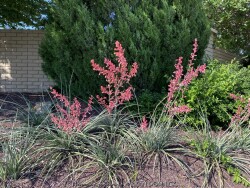

Texas Red Yucca (Hesperaloe parviflora) is a slow-growing broadleaf evergreen perennial with tall coral red flowers! Surprisingly, a native of Northeastern Mexico and Southwestern Texas can handle our extreme cold and wetness of Lawrence, KS! Normally thriving in hot, dry, desert conditions, is also surprisingly winter hardy to USDA Zone 5. Medium to blue-green leaves form rosettes about 2-3 feet tall and wide. Tall red flower spikes reliably appear on mature plants from July to October lasting 3-4 months in Kansas. If pollination is successful, attractive seed heads form later turning to black before cracking open in winter. Tough as nails, yuccas are the ideal plant for a no-maintenance garden. Normally a plant has specific requirements for success but this yucca has only a few: it cannot tolerate poorly drained soils, full shade, or North exposures. This and other yuccas look best when combined with other flowering plants providing texture and color. In mass plantings, red yucca can create an interesting architectural look. Combined with ornamental grasses, red yucca can create stunning contrasts with winter grass colors of pink, orange and rust. Red flowers are pollinated by hummingbirds and certainly deserve a place in native plant / pollinator garden. Not a true yucca, this is actually a Hesperaloe, a closely related genus also related to century plants. A large group of Hesperaloe survived -16 degrees F and a week of single digit highs in February, 2021 with no mulch. I have also seen miles upon miles of this plant growing in the medians along multi-lane interstates in Dallas. All plants were healthy looking with no missing or dying plants; truely a tough plant. Truely a 4-seasons plant for your yard!
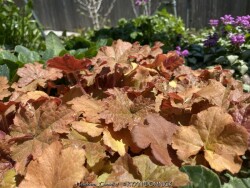

Caramel coral bells (Heuchera 'Caramel') are planted for its unusual orange-copper-peach evergreen leaf colors. Tiny light pink flowers also appear in early summer. Foliage maintains well as a non-spreading clump all year provided that certain cultural conditions are met. Native to Eastern U.S. forests in humusy, medium well-drained soil in part shade to full shade, it needs constantly moist soil rich in organic matter but avoid clay. Summer droughts and temperatures over 100 degrees F. are stressful for coral belles. If low temperatures hit -10 degrees F, foliage finally dies back to the ground and re-emerges in early spring. Useful in Kansas landscapes as a small scale groundcover in part shade or morning sun. Color is less intense in full shade. Generally this plant declines after a few years of Kansas climate but worth a try in perfect soils in well-tended shade gardens. Preferring northern climates, lack of moisture, alkaline soils, and competition with weeds seem to be an issue. 'Carmel' is a villosa hybrid with glowing golden-orange leaves turning a bit more apricot with warmer weather. Foliage is fuzzy giving the plants a more frosted look. For a coral bell, this cultivar is very heat and humidity tolerant; a vigorous grower. We have a specimen thriving in our Lawrence, KS, for over 10 years needing very little care; it gets morning sun, regular irrigation, and that's about it! All Proven Winners® plants are legally propagated, healthy and vigorous, true to name, and tagged with color pictures and growing information.


Obsidian Coral Bells (Heuchera x 'Obsidian') are planted for its unusual orange-copper-peach evergreen leaf colors. Tiny light pink flowers also appear in early summer. Foliage maintains well as a non-spreading clump all year provided that certain cultural conditions are met. Native to Eastern U.S. forests in humusy, medium well-drained soil in part shade to full shade, it needs constantly moist soil rich in organic matter but avoid clay. Summer droughts and temperatures over 100 degrees F. are stressful for coral belles. If low temperatures hit -10 degrees F, foliage finally dies back to the ground and re-emerges in early spring. Useful in Kansas landscapes as a small scale groundcover in part shade or morning sun. Color is less intense in full shade. Generally this plant declines after a few years of Kansas climate but worth a try in perfect soils in well-tended shade gardens. Preferring northern climates, lack of moisture, alkaline soils, and competition with weeds seem to be an issue. 'Carmel' is a villosa hybrid with glowing golden-orange leaves turning a bit more apricot with warmer weather. Foliage is fuzzy giving the plants a more frosted look. For a coral bell, this cultivar is very heat and humidity tolerant; a vigorous grower. We have a specimen thriving in our Lawrence, KS, for over 10 years needing very little care; it gets morning sun, regular irrigation, and that's about it! All Proven Winners® plants are legally propagated, healthy and vigorous, true to name, and tagged with color pictures and growing information.
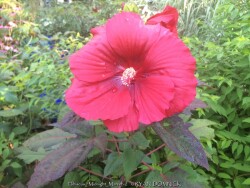

Hardy Hibiscus are US native plants that feature very large single petal flowers sometimes as large as a dinner plate. Colors include white, pink, red, magenta, purple with many different combinations. Foliage can range from green to reddish to dark purplish black. Hardy hibiscus breeding to produce improved cultivars has come a long way in the last 10 or 20 years. Hibiscus emerge later than most other perennials, needing the ground to heat up before growing in May. Hibiscus tolerate a wide range of soil conditions including clay and wetness but prefer rich garden soil. Drought is tolerated with established plants although flowering will be reduced. Generally, the 40 inches of rainfall in Eastern Kansas is sufficient. Full sun is best for optimal foliage coloring, growth habit, and flowers. When used in a landscape, hibiscus brings a tropical feel when flowering and are noticeable from very far away. Combine with hardy bananas (musa basjoo) and other contrasting flowers. Groupings of hibiscus are very effective around water gardens, rain gardens, backyard fences, pollinator gardens, and roadside areas where you only have a second to look when driving by. Modern hibiscus cultivars do not set seed and do not need to be deadheaded like old varieties; the result is continuous blooming from July till September. Cool autumn nights below 50 degrees F initiate beautiful fall foliage colors ranging from red and purple to fiery orange. Maintenance is pretty easy: just cut down dead stocks to the ground at some point in fall or winter. A yearly time-release fertilizer is appreciated from most heavily flowering plants. There are some occasional foliage pests for hibiscuses including leaf miners, grasshoppers, and Japanese beetles but these can be treated. If not treated, it generally won't kill the plant, especially if the plant is otherwise healthy and in good growing conditions. Hibiscus 'Midnight Marvel' is a Walters Gardens Inc. introduction. This variety combines the deep wine-purple, maple-like foliage of 'Perfect Storm' and the scarlet red, 8-9" flowers of 'Cranberry Crush'. From 'Cranberry Crush', it inherits very similar glossy, black-red buds which open to 8-9", deep scarlet red flowers. The habit is relatively compact, measuring in at 4' tall x 4½' wide. Since this variety is an indeterminate bloomer (has buds at several nodes up the stem), it blooms for an extended period from midsummer into early fall. All-day full sun is needed for dark foliage color.
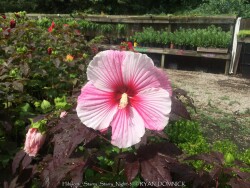

Hardy Hibiscus are US native plants that feature very large single petal flowers sometimes as large as a dinner plate. Colors include white, pink, red, magenta, purple with many different combinations. Foliage can range from green to reddish to dark purplish black. Hardy hibiscus breeding to produce improved cultivars has come a long way in the last 10 or 20 years. Hibiscus emerge later than most other perennials, needing the ground to heat up before growing in May. Hibiscus tolerate a wide range of soil conditions including clay and wetness but prefer rich garden soil. Drought is tolerated with established plants although flowering will be reduced. Generally, the 40 inches of rainfall in Eastern Kansas is sufficient. Full sun is best for optimal foliage coloring, growth habit, and flowers. When used in a landscape, hibiscus brings a tropical feel when flowering and are noticeable from very far away. Combine with hardy bananas (musa basjoo) and other contrasting flowers. Groupings of hibiscus are very effective around water gardens, rain gardens, backyard fences, pollinator gardens, and roadside areas where you only have a second to look when driving by. Modern hibiscus cultivars do not set seed and do not need to be deadheaded like old varieties; the result is continuous blooming from July till September. Cool autumn nights below 50 degrees F initiate beautiful fall foliage colors ranging from red and purple to fiery orange. Maintenance is pretty easy: just cut down dead stocks to the ground at some point in fall or winter. A yearly time-release fertilizer is appreciated from most heavily flowering plants. There are some occasional foliage pests for hibiscuses including leaf miners, grasshoppers, and Japanese beetles but these can be treated. If not treated, it generally won't kill the plant, especially if the plant is otherwise healthy and in good growing conditions. Hibiscus 'Starry Starry Night' is a Walters Gardens Inc. introduction. Incredibly dark, near-black, broad, maple-like leaves form an upright clump in the landscape. Interesting 7-8" flowers are pale pink with darker pink speckling and veining. The flowers are held on bright green carpels, which contrast nicely with the dark foliage. Flowers are produced from the top to the bottom of the plant, rather than only at the top like some older cultivars.
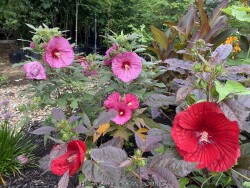

Hardy Hibiscus are US native plants that feature very large single petal flowers sometimes as large as a dinner plate. Colors include white, pink, red, magenta, purple with many different combinations. Foliage can range from green to reddish to dark purplish black. Hardy hibiscus breeding to produce improved cultivars has come a long way in the last 10 or 20 years. Hibiscus emerge later than most other perennials, needing the ground to heat up before growing in May. Hibiscus tolerate a wide range of soil conditions including clay and wetness but prefer rich garden soil. Drought is tolerated with established plants although flowering will be reduced. Generally, the 40 inches of rainfall in Eastern Kansas is sufficient. Full sun is best for optimal foliage coloring, growth habit, and flowers. When used in a landscape, hibiscus brings a tropical feel when flowering and are noticeable from very far away. Combine with hardy bananas (musa basjoo) and other contrasting flowers. Groupings of hibiscus are very effective around water gardens, rain gardens, backyard fences, pollinator gardens, and roadside areas where you only have a second to look when driving by. Modern hibiscus cultivars do not set seed and do not need to be deadheaded like old varieties; the result is continuous blooming from July till September. Cool autumn nights below 50 degrees F initiate beautiful fall foliage colors ranging from red and purple to fiery orange. Maintenance is pretty easy: just cut down dead stocks to the ground at some point in fall or winter. A yearly time-release fertilizer is appreciated from most heavily flowering plants. There are some occasional foliage pests for hibiscuses including leaf miners, grasshoppers, and Japanese beetles but these can be treated. If not treated, it generally won't kill the plant, especially if the plant is otherwise healthy and in good growing conditions.
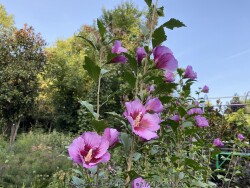

You've never seen a Rose Of Sharon like this before! Purple Pillar® (Hibiscus syriacus 'Purple Pillar') is a totally unique Rose Of Sharon: it naturally grows as a narrow column instead of a wide, spreading plant. It gets to be just 2-3' (.6-.9 m) wide and 10-16' tall! Think of what you could do with that: screens, hedges, patio containers. Anywhere you need a little privacy and/or color in a narrow space, this plant is a great choice. Like most all hibiscus, it will do best in full sun. It is hardy to USDA Zone 5. In summer, each stem is packed along its entire length with purple blooms. This unusual columnar habit makes it a real space saver - if you thought you didn't have enough space to grow Rose Of Sharon, Purple Pillar is perfect for you. Try it in containers, or flanking your front door, or simply as a quirky accent in your landscape. The narrow habit of Purple Pillar Rose Of Sharon means it creates few to no branches, so little to no pruning is required. If you want to prune it, do so in early spring. In areas that experience snowfall, avoid planting it where it might be dumped on by snow falling off of the roof - yours, or your neighbors. In Eastern Kansas, this cultivar performs WELL with just about everything nature has to challenge it! Heat and drought are tolerated full sun or part shade. Our typical 40 inches of rainfall is sufficient without extra water if planted in good soils. Cold tolerance is no problem. No disease or pest problems. Only issue is that seeds will form and re-seeding does not coming true to form: we recommend spraying round-up as seedling appear around the base of the original true Purple Pillar shrubs. You don't want any "non-pillar" wild troublemakers messing up your line. All Proven Winners® plants are legally propagated, healthy and vigorous, true to name, and tagged with color pictures and growing information.
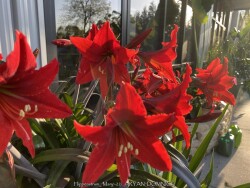

Mary's Hardy Red Amaryllis (Hippeastrum 'Mary') is a cultivar named by Ryan Domnick after his mother Mary. Mary Domnick had grown this beautiful unknown variety for over a decade in the 1980's and 1990's. The glossy green strap-like leaves emerge in spring emerge with a reddish tint. Deep red velvety flowers have a darker red throat and last for about a month. Foliage remains attractive all summer with plenty of heat tolerance. No other cultivars match this pure deep red color! The plants are temperate and subtropical herbaceous perennial bulbs native to areas with a summer wet season and dry winter. Mary's Hardy Red Amaryllis are hardy outside as a perennial when established and mulched at least to zone 6a. During the growing season, fertilize, water regularly, and plant in full sun. Plant these bulbs in the ground at least 6-8" deep with 3-4" of mulch to enjoy a wonderful tropical flowering effect! Trim back foliage after first fall freeze. They can also be grown as a flowering summer patio plant. If growing as a potted plant and trying to overwinter, allowing the foliage to frost is ok, it will not kill the root system. However, do not allow the pot with rootball to freeze solid or go below 20 degrees for more than a few hours; move into a cold garage or basement over the winter with no watering. Cut back and allow to go dormant and place entire pot back out in April or May with a time-release fertilizer. Another more labor intensive way to overwinter gladiolus is to remove them from the dirt, dust with fungicide, place in box with sawdust, and keep in the refrigerator. We consider this method old-fashioned and too much work but ok if you only want to save a few bulbs. If digging from the ground in colder zones, just save a big chunk with the dirt intact and place into a large pot in the garage. In our display garden in Lawrence, KS (zone 6a), several established specimens planted over 4-6" deep and mulched 2-3" with wood mulch survived -17 degrees F. During the arctic blast of February, 2021, lows down to -17 degrees F on Feb 16th, 2021 were recorded. The longevity of this cold blast was also impressive: 10 days on a row with highs of 10-15 degrees F or lower, 8 nights of lows in the single digits and negatives, and 36 straight hours of 0 degrees F and mostly lower. These have been in the ground for over 10 years and muscled through other periods of below zero cold weather.
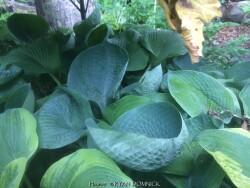

Hosta by far is the most popular and well-known shade plant in the United States. Many thousands of cultivars exist from original species native to China, Japan, and other forested areas in Asia. Hosta foliage arises from a clump-forming root system and is often large and dramatic with many types of variegation. Flowers, born on tall stocks ranging in shades of white and purple, are equally attractive. Hostas grow best in rich, well-drained soils in full to partial shade. In Eastern Kansas with our average 40 inches of average rainfall, plants are drought tolerant if established in moisture-retentive high-quality soil. Dry-shade areas are best avoided. Afternoon sun with temperatures over 95 degrees F but likely burn the tips of hosta foliage rendering them unattractive for the rest of the year. There is no secondary growth by late summer after flowering and after buds have been set for next year. In northern parts of the country, hostas can handle full sun. In the Southern part of their range further South than zone 7, hosta can really struggle through the long summer heat unless conditions are perfect. Rabbits, deer, slugs, and snails can be a problem generally on small or un-established plants. Large-leaf robust varieties seem to outgrow browsing predators better than small dainty varieties. Methods of control are effective ranging from cages to deer repellents. Generally, a large established planting of hostas will be there for decades gradually getting thicker and denser without a need to divide. Many plantings have been in our display garden for 15-20 years with no weeds ever trying to grow in the shade of the foliage. Hosta foliage is susceptible to late spring freezes so try to cover if possible. During the Easter freeze of April, 2007, thousands of hosta were killed to the ground in eastern Kansas but all returned successfully by May from secondary buds. Hosta's newly unfurling foliage is considered edible when cooked like asparagus or eaten raw in salads. Hosta 'Abiqua Drinking Gourd' is a medium (large) puckered, powder-blue leaves with chalky undersides are uniquely upward facing and deeply cupped. White flowers bloom midsummer; very slug resistant.
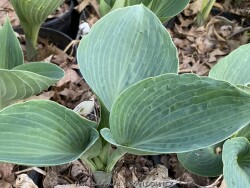

Hosta by far is the most popular and well-known shade plant in the United States. Many thousands of cultivars exist from original species native to China, Japan, and other forested areas in Asia. Hosta foliage arrises from a clump-forming root system and is often large and dramatic with many types of variegation. Flowers, born on tall stocks ranging in shades of white and purple, are equally attractive. Hostas grow best in rich, well-drained soils in full to partial shade. In Eastern Kansas with our average 40 inches of average rainfall, plants are drought tolerant if established in moisture-retentive high-quality soil. Dry-shade areas are best avoided. Afternoon sun with temperatures over 95 degrees F but likely burn the tips of hosta foliage rendering them unattractive for the rest of the year. There is no secondary growth by late summer after flowering and after buds have been set for next year. In northern parts of the country, hostas can handle full sun. In the Southern part of their range further South than zone 7, hosta can really struggle through the long summer heat unless conditions are perfect. Rabbits, deer, slugs, and snails can be a problem generally on small or un-established plants. Large-leaf robust varieties seem to outgrow browsing predators better than small dainty varieties. Methods of control are effective ranging from cages to deer repellents. Generally, a large established planting of hostas will be there for decades gradually getting thicker and denser without a need to divide. Many plantings have been in our display garden for 15-20 years with no weeds ever trying to grow in the shade of the foliage. Hosta foliage is susceptible to late spring freezes so try to cover if possible. During the Easter freeze of April, 2007, thousands of hosta were killed to the ground in eastern Kansas but all returned successfully by May from secondary buds. Hosta's newly unfurling foliage is considered edible when cooked like asparagus or eaten raw in salads. Hosta 'Bulletproof' has extremely thick blue leaves that look good all season: very resistant to slugs and snails. Sport of 'Halcyon'
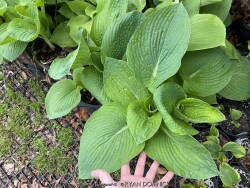

Hosta by far is the most popular and well-known shade plant in the United States. Many thousands of cultivars exist from original species native to China, Japan, and other forested areas in Asia. Hosta foliage arrises from a clump-forming root system and is often large and dramatic with many types of variegation. Flowers, born on tall stocks ranging in shades of white and purple, are equally attractive. Hostas grow best in rich, well-drained soils in full to partial shade. In Eastern Kansas with our average 40 inches of average rainfall, plants are drought tolerant if established in moisture-retentive high-quality soil. Dry-shade areas are best avoided. Afternoon sun with temperatures over 95 degrees F but likely burn the tips of hosta foliage rendering them unattractive for the rest of the year. There is no secondary growth by late summer after flowering and after buds have been set for next year. In northern parts of the country, hostas can handle full sun. In the Southern part of their range further South than zone 7, hosta can really struggle through the long summer heat unless conditions are perfect. Rabbits, deer, slugs, and snails can be a problem generally on small or un-established plants. Large-leaf robust varieties seem to outgrow browsing predators better than small dainty varieties. Methods of control are effective ranging from cages to deer repellents. Generally, a large established planting of hostas will be there for decades gradually getting thicker and denser without a need to divide. Many plantings have been in our display garden for 15-20 years with no weeds ever trying to grow in the shade of the foliage. Hosta foliage is susceptible to late spring freezes so try to cover if possible. During the Easter freeze of April, 2007, thousands of hosta were killed to the ground in eastern Kansas but all returned successfully by May from secondary buds. Hosta's newly unfurling foliage is considered edible when cooked like asparagus or eaten raw in salads. Hosta 'Elegans' is an older variety with giant heart-shaped heavily puckered blue-gray leaves are pest resistant. Near white flowers on short scapes.


Hosta by far is the most popular and well-known shade plant in the United States. Many thousands of cultivars exist from original species native to China, Japan, and other forested areas in Asia. Hosta foliage arrises from a clump-forming root system and is often large and dramatic with many types of variegation. Flowers, born on tall stocks ranging in shades of white and purple, are equally attractive. Hostas grow best in rich, well-drained soils in full to partial shade. In Eastern Kansas with our average 40 inches of average rainfall, plants are drought tolerant if established in moisture-retentive high-quality soil. Dry-shade areas are best avoided. Afternoon sun with temperatures over 95 degrees F but likely burn the tips of hosta foliage rendering them unattractive for the rest of the year. There is no secondary growth by late summer after flowering and after buds have been set for next year. In northern parts of the country, hostas can handle full sun. In the Southern part of their range further South than zone 7, hosta can really struggle through the long summer heat unless conditions are perfect. Rabbits, deer, slugs, and snails can be a problem generally on small or un-established plants. Large-leaf robust varieties seem to outgrow browsing predators better than small dainty varieties. Methods of control are effective ranging from cages to deer repellents. Generally, a large established planting of hostas will be there for decades gradually getting thicker and denser without a need to divide. Many plantings have been in our display garden for 15-20 years with no weeds ever trying to grow in the shade of the foliage. Hosta foliage is susceptible to late spring freezes so try to cover if possible. During the Easter freeze of April, 2007, thousands of hosta were killed to the ground in eastern Kansas but all returned successfully by May from secondary buds. Hosta's newly unfurling foliage is considered edible when cooked like asparagus or eaten raw in salads. Hosta 'Halcyon' is a medium height cultivar. It features spearhead-shaped chalky-blue leaves with heavy ribbing and pale lavender flowers. Thick substance, pest resistant, tolerates partial sun.
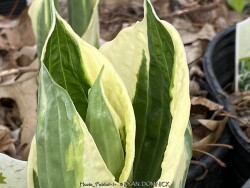

Hosta by far is the most popular and well-known shade plant in the United States. Many thousands of cultivars exist from original species native to China, Japan, and other forested areas in Asia. Hosta foliage arrises from a clump-forming root system and is often large and dramatic with many types of variegation. Flowers, born on tall stocks ranging in shades of white and purple, are equally attractive. Hostas grow best in rich, well-drained soils in full to partial shade. In Eastern Kansas with our average 40 inches of average rainfall, plants are drought tolerant if established in moisture-retentive high-quality soil. Dry-shade areas are best avoided. Afternoon sun with temperatures over 95 degrees F but likely burn the tips of hosta foliage rendering them unattractive for the rest of the year. There is no secondary growth by late summer after flowering and after buds have been set for next year. In northern parts of the country, hostas can handle full sun. In the Southern part of their range further South than zone 7, hosta can really struggle through the long summer heat unless conditions are perfect. Rabbits, deer, slugs, and snails can be a problem generally on small or un-established plants. Large-leaf robust varieties seem to outgrow browsing predators better than small dainty varieties. Methods of control are effective ranging from cages to deer repellents. Generally, a large established planting of hostas will be there for decades gradually getting thicker and denser without a need to divide. Many plantings have been in our display garden for 15-20 years with no weeds ever trying to grow in the shade of the foliage. Hosta foliage is susceptible to late spring freezes so try to cover if possible. During the Easter freeze of April, 2007, thousands of hosta were killed to the ground in eastern Kansas but all returned successfully by May from secondary buds. Hosta's newly unfurling foliage is considered edible when cooked like asparagus or eaten raw in salads.
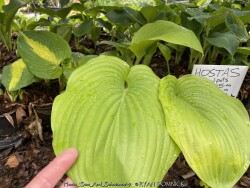

Hosta by far is the most popular and well-known shade plant in the United States. Many thousands of cultivars exist from original species native to China, Japan, and other forested areas in Asia. Hosta foliage arrises from a clump-forming root system and is often large and dramatic with many types of variegation. Flowers, born on tall stocks ranging in shades of white and purple, are equally attractive. Hostas grow best in rich, well-drained soils in full to partial shade. In Eastern Kansas with our average 40 inches of average rainfall, plants are drought tolerant if established in moisture-retentive high-quality soil. Dry-shade areas are best avoided. Afternoon sun with temperatures over 95 degrees F but likely burn the tips of hosta foliage rendering them unattractive for the rest of the year. There is no secondary growth by late summer after flowering and after buds have been set for next year. In northern parts of the country, hostas can handle full sun. In the Southern part of their range further South than zone 7, hosta can really struggle through the long summer heat unless conditions are perfect. Rabbits, deer, slugs, and snails can be a problem generally on small or un-established plants. Large-leaf robust varieties seem to outgrow browsing predators better than small dainty varieties. Methods of control are effective ranging from cages to deer repellents. Generally, a large established planting of hostas will be there for decades gradually getting thicker and denser without a need to divide. Many plantings have been in our display garden for 15-20 years with no weeds ever trying to grow in the shade of the foliage. Hosta foliage is susceptible to late spring freezes so try to cover if possible. During the Easter freeze of April, 2007, thousands of hosta were killed to the ground in eastern Kansas but all returned successfully by May from secondary buds. Hosta's newly unfurling foliage is considered edible when cooked like asparagus or eaten raw in salads. Hosta 'Sum and Substance' is a giant! It features huge chartreuse round leaves with heavy puckering, very thick substance; slug resistant. Vigorous; requires some sun to enhance its golden color. Lavender flowers on tall 50" scapes.
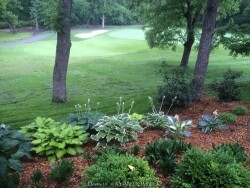

Hosta by far is the most popular and well-known shade plant in the United States. Many thousands of cultivars exist from original species native to China, Japan, and other forested areas in Asia. Hosta foliage arrises from a clump-forming root system and is often large and dramatic with many types of variegation. Flowers, born on tall stocks ranging in shades of white and purple, are equally attractive. Hostas grow best in rich, well-drained soils in full to partial shade. In Eastern Kansas with our average 40 inches of average rainfall, plants are drought tolerant if established in moisture-retentive high-quality soil. Dry-shade areas are best avoided. Afternoon sun with temperatures over 95 degrees F but likely burn the tips of hosta foliage rendering them unattractive for the rest of the year. There is no secondary growth by late summer after flowering and after buds have been set for next year. In northern parts of the country, hostas can handle full sun. In the Southern part of their range further South than zone 7, hosta can really struggle through the long summer heat unless conditions are perfect. Rabbits, deer, slugs, and snails can be a problem generally on small or un-established plants. Large-leaf robust varieties seem to outgrow browsing predators better than small dainty varieties. Methods of control are effective ranging from cages to deer repellents. Generally, a large established planting of hostas will be there for decades gradually getting thicker and denser without a need to divide. Many plantings have been in our display garden for 15-20 years with no weeds ever trying to grow in the shade of the foliage. Hosta foliage is susceptible to late spring freezes so try to cover if possible. During the Easter freeze of April, 2007, thousands of hosta were killed to the ground in eastern Kansas but all returned successfully by May from secondary buds. Hosta's newly unfurling foliage is considered edible when cooked like asparagus or eaten raw in salads.
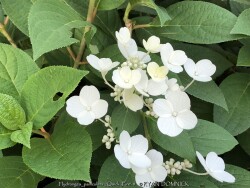

Quick Fire Fab® Panicle Hydrangea (Hydrangea paniculata 'Quick Fire Fab') is the first to bloom! Quick Fire blooms about a month before any other panicle hydrangea. Flowers open pure white then turn pink, and will be an extremely dark rosy-pink in the fall. The flower color on Quick Fire hydrangea is not affected by soil pH. Blooms on this super-hardy and easy to grow hydrangea are produced on new wood, which means that you will see flowers even after even the harshest winters. Beautiful for use as a cut (fresh or dried) flower. Unlike other panicle hydrangeas, Quick Fire Fab also has excellent fall foliage color for a final hurrah before winter. This is a very hardy flowering shrub good for full sun locations - the hotter your climate, however, the more shade the plant will require. Good for groupings and in mass plantings, shrub and perennial borders, as a specimen, a screen or a hedge. Panicle hydrangeas like Quick Fire Fab are very easy to care for. They can grow in most soils, provided they are well-drained. Panicle hydrangeas bloom on new wood, which means they can be pruned in spring and will still bloom that season. We recommend cutting them back by about one-third their total height in early spring, just as the new growth is beginning to emerge on the stems. This will serve to remove the spent blooms and ensure that the season's growth comes from the heavier, thicker buds further down the plant. If blooms do not age to pink and red, this indicates that the plant is either in too much shade, that it experienced drought stress, or that night time temperatures were unusually high. In Eastern Kansas, this cultivar performs reasonably well. Heat and drought are tolerated if in morning sun. In full sun provide ample water and expect some leaf burn if summer temperatures exceed 100 degrees F. Cold tolerance is no problem. No disease or pest problems. All Proven Winners® plants are legally propagated, healthy and vigorous, true to name, and tagged with color pictures and growing information.
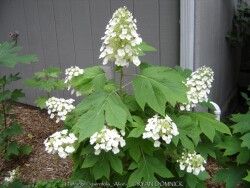

>>>>>Oakleaf hydrangea (Hydrangea quercifolia) is a large coarse-textured deciduous shrub growing to 3-10 feet tall with an open crown native to the southeastern United States. Cone-shaped flower clusters emerge bright white in mid-summer. Flowers age to progressively darker shades of pink and by autumn and become persistent dried flower-heads in winter. The leaves are dark green on top and silvery-white underneath. Plants in shade have larger leaves than those grown in sun. In sun, if drought stress occurs, foliage becomes tattered, burnt, and yellowish; ruining potential fall color. The leaves of healthy plants turn rich shades of red, bronze and purple in autumn that persist until about 25 degrees F usually into late November in Kansas. The plant slowly sprouts shoots from underground stolons and often grows in colonies in ideal conditions but this is rare in Kansas. Young stems are covered in a felt-like light brown bark while the larger stems develop an attractive cinnamon-tan-orange bark that shreds and peels in thin flakes. Hydrangea quercifolia is best grown in rich, medium moisture, well-drained soils in part shade. Drought and full sun tolerance are average but greatly improved with rich, moisture-retentive foresty soils. Plant near gutter downspouts for an extra boost of water. It will tolerate drought, but may not flower. In Eastern Kansas, Cold tolerance is no problem. No significant disease or pest problems. Of all the hydrangeas, this is probably the toughest! Several improved cultivars have been developed.
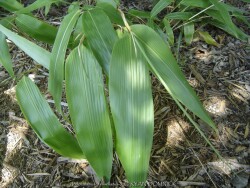

Largeleaf Groundcover Bamboo / Indocalamus, is also known as Indocalamus tessellatus
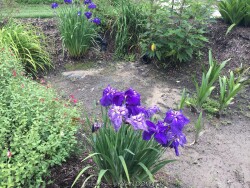

>>>>>This plant can also be used as a marginal aquatic plant growing in shallow water. It can also grow as a bog plant needing constantly moist soil rich in organic matter. As a rain garden plant, it will thrive is a depressed area in the landscape that collects rain water from a roof during spring and summer periods of rain but then go dormant if the water hole dries out completely.
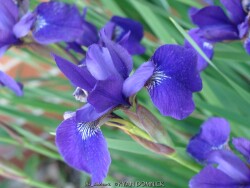

>>>>>This plant can also be used as a marginal aquatic plant growing in shallow water. It can also grow as a bog plant needing constantly moist soil rich in organic matter. As a rain garden plant, it will thrive is a depressed area in the landscape that collects rain water from a roof during spring and summer periods of rain but then go dormant if the water hole dries out completely.
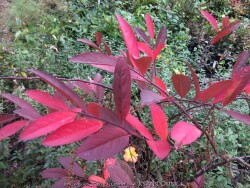

Virginia sweetspire (Itea virginica) is a native shrub found along creeks and streams in the eastern United States. Foliage consists of a simple leaf, medium to light green, and usually glossy. White cascading flowers cover the plants in spring for about a month with pollinators flocking to the occasion. Fall color is outstanding shades of red and purple. Leaves cling to the stem and are very persistent down to about 10-15°F often finally dropping in December. Stems during the winter take on an attractive reddish-brown and green coloring. Sweetspire is truly a four-season shrub! In the landscape, combine with native plants, hardy tropicals, or summer flowering plants. These plants can tolerate saturated soils and are perfect for rain gardens or any other rich soil garden areas. North exposures are fine in zone 6 but not any further north as winter kill becomes a problem in zone 5. Water is usually the limiting factor in southern climates zone 7-9. Sweetspire is highly sensitive to iron chlorosis so avoid alkaline soils. In our eastern Kansas climate, we avoid afternoon sun and dry soils. Full shade is tolerated but not dry shade. Fall color will be reduced or nonexistent in full shade. Morning sun is best for avoiding leaf burn but still allowing fall coloring. Overall, this is a great garden plant when sited in the right conditions. Itea virginica 'Henry's Garnet' has larger flowers and better fall color compared to the species.
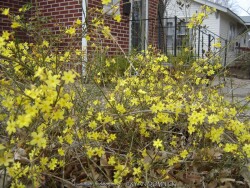

Winter Jasmine (Jasminium nudiflorum) is a spreading dwarf shrub native to China. It features dark green glossy leaves that remain attractive all summer. The density of the shrub overtime is unmatched, completely eliminating any weeds including tree seedlings from emerging. Bright yellow five-petaled flowers resembling forsythia bloom extremely early in the spring usually in February or March before foliage growth (in Lawrence, KS). Flower buds are hardy to about 0° so flowering may not occur every year if temperatures get lower. Occasionally this shrub will bloom in the middle of winter when we have a 2-3 week warm spell. When it does bloom, it creates a spectacular show completely covering the shrub. It will grow in full sun or full shade in medium to dry soils including some dry-shade. It tolerates moist soils and brief periods of saturated soils after heavy rains. Fall color is yellow but drops quickly. Stems take on an olive greenish color in winter rendering them mildly attractive. Winter jasmine is commonly grown as a spreading groundcover shrub for difficult areas, frequently used as large mass planting on hills. Because of its tolerance for adverse conditions including poor soil and rock, it is often one of the last resort plants that will survive in certain areas. It competes well under large shade trees and helps absorb leaf litter allowing it to break down and add nutrients back to the soil. This plant also does well in hot dry parking lot islands, hell strips, and along busy roads in full sun. Another great spot is planting on top of a retaining wall allowing it to cascade down. Further uses include erosion control and streambank stabilization. We do not recommend planting in small areas or in spaces that it will overrun neighboring plants. It only spreads above ground as horizontally growing stems touch the ground and root. This does make maintenance easier to control the spread of the plant versus digging out rhizomes. Avoid North exposures and wet soils. Considered one of the most versatile and best plants for solving difficult landscape challenges.
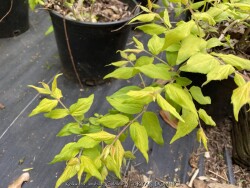

Goldleaf/Golden Beauty Beautybush, is also known as Kolkwitzia amabilis 'Goldleaf'
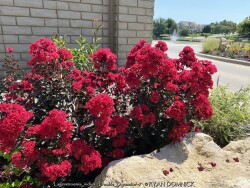

Crapemyrtle (Lagerstroemia) is a beautiful summer flowering shrub that dies down to the ground as a perennial each year in Zone 6 Kansas. Flower colors include bright red, pink, magenta, purple, and white. Many cultivars have been released improving foliage color, disease resistance, and flower blooming length. Newer cultivars now have maroon or reddish foliage adding interest before blooming. Beautiful fall color is often overlooked; shades of red, orange, and purple develop when Night temperatures reach into the 40s. In Kansas, crape myrtles grow best with hot south or west exposures or on south facing berms or hillsides. But they are suitable in any garden location as long as they are in full sun, they will build enough energy to come back from complete winter top-kill each year. Generally are 40 inches of rain per year is sufficient without extra watering, but if drought conditions occur, flowering will be reduced or shortened. Brief periods of excessive water and saturated soils are tolerated adding to their versatility. Many people from the south associate Crapemyrtles as a tree. That is true that in Texas and much of the Southeast, beautiful tree forms with exfoliating bark will occur because of mild winters. In Oklahoma and Arkansas for example crapemyrtles are usually grown as large shrubs experiencing major winterkill every 5-10 years. In Kansas and Missouri, or where temperatures regularly get to 0°, all top growth will die back and they will be grown as a woody perennial. After flowering and beautiful fall color is dropped, many people leave crapemyrtles throughout the winter to enjoy the winter interest of the dried seed heads. By March or April, cut plants close to the ground and watch for new growth. Flowering occurs on new wood and is much larger and more dramatic on sprouts from the ground. Flowers are often twice as big when grown this way. In the past, only fast-growing tree size cultivars for appropriate and Kansas because they have the ability to recover the fastest from complete winterkill and grow into a flowering-sized shrub by July. Now there are dwarf cultivars that are wood-hardy to -10 zone 6 for those not wanting to worry about winterkill. No disease or pest problems. Crapemyrtle are awesome for pollinators in the late season garden and especially effective when combined with vitex, butterfly bush, and/or caryopteris. Lagerstroemia indica 'Double Dynamite' is a new variety from Dr. Carl Whitcomb. It would be notable simply for its vivid cherry-red flowers and deep purple foliage, but its ability to bloom continuously on the same panicle make it positively extraordinary. Enjoy over 100 days of bloom on a handsome, disease resistant plant.
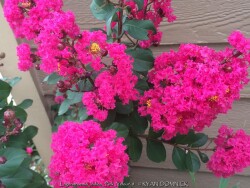

Crapemyrtle (Lagerstroemia) is a beautiful summer flowering shrub that dies down to the ground as a perennial each year in Zone 6 Kansas. Flower colors include bright red, pink, magenta, purple, and white. Many cultivars have been released improving foliage color, disease resistance, and flower blooming length. Newer cultivars now have maroon or reddish foliage adding interest before blooming. Beautiful fall color is often overlooked; shades of red, orange, and purple develop when Night temperatures reach into the 40s. In Kansas, crape myrtles grow best with hot south or west exposures or on south facing berms or hillsides. But they are suitable in any garden location as long as they are in full sun, they will build enough energy to come back from complete winter top-kill each year. Generally are 40 inches of rain per year is sufficient without extra watering, but if drought conditions occur, flowering will be reduced or shortened. Brief periods of excessive water and saturated soils are tolerated adding to their versatility. Many people from the south associate Crapemyrtles as a tree. That is true that in Texas and much of the Southeast, beautiful tree forms with exfoliating bark will occur because of mild winters. In Oklahoma and Arkansas for example crapemyrtles are usually grown as large shrubs experiencing major winterkill every 5-10 years. In Kansas and Missouri, or where temperatures regularly get to 0°, all top growth will die back and they will be grown as a woody perennial. After flowering and beautiful fall color is dropped, many people leave crapemyrtles throughout the winter to enjoy the winter interest of the dried seed heads. By March or April, cut plants close to the ground and watch for new growth. Flowering occurs on new wood and is much larger and more dramatic on sprouts from the ground. Flowers are often twice as big when grown this way. In the past, only fast-growing tree size cultivars for appropriate and Kansas because they have the ability to recover the fastest from complete winterkill and grow into a flowering-sized shrub by July. Now there are dwarf cultivars that are wood-hardy to -10 zone 6 for those not wanting to worry about winterkill. No disease or pest problems. Crapemyrtle are awesome for pollinators in the late season garden and especially effective when combined with vitex, butterfly bush, and/or caryopteris. Lagerstroemia indica 'Pink Velour', developed by Dr. Carl Whitcomb, has deep pink long-lasting flowers. Deep wine red leaves emerge in spring and age to dark purplish green creating quite a contrast with bright flowers.
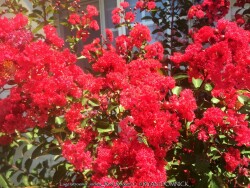

Crapemyrtle (Lagerstroemia) is a beautiful summer flowering shrub that dies down to the ground as a perennial each year in Zone 6 Kansas. Flower colors include bright red, pink, magenta, purple, and white. Many cultivars have been released improving foliage color, disease resistance, and flower blooming length. Newer cultivars now have maroon or reddish foliage adding interest before blooming. Beautiful fall color is often overlooked; shades of red, orange, and purple develop when Night temperatures reach into the 40s. In Kansas, crape myrtles grow best with hot south or west exposures or on south facing berms or hillsides. But they are suitable in any garden location as long as they are in full sun, they will build enough energy to come back from complete winter top-kill each year. Generally are 40 inches of rain per year is sufficient without extra watering, but if drought conditions occur, flowering will be reduced or shortened. Brief periods of excessive water and saturated soils are tolerated adding to their versatility. Many people from the south associate Crapemyrtles as a tree. That is true that in Texas and much of the Southeast, beautiful tree forms with exfoliating bark will occur because of mild winters. In Oklahoma and Arkansas for example crapemyrtles are usually grown as large shrubs experiencing major winterkill every 5-10 years. In Kansas and Missouri, or where temperatures regularly get to 0°, all top growth will die back and they will be grown as a woody perennial. After flowering and beautiful fall color is dropped, many people leave crapemyrtles throughout the winter to enjoy the winter interest of the dried seed heads. By March or April, cut plants close to the ground and watch for new growth. Flowering occurs on new wood and is much larger and more dramatic on sprouts from the ground. Flowers are often twice as big when grown this way. In the past, only fast-growing tree size cultivars for appropriate and Kansas because they have the ability to recover the fastest from complete winterkill and grow into a flowering-sized shrub by July. Now there are dwarf cultivars that are wood-hardy to -10 zone 6 for those not wanting to worry about winterkill. No disease or pest problems. Crapemyrtle are awesome for pollinators in the late season garden and especially effective when combined with vitex, butterfly bush, and/or caryopteris. Lagerstroemia indica 'Red Rocket', developed by Dr. Carl Whitcomb, features brilliant cherry-red flowers with dark green foliage. It is one of the fastest growing crape myrtles reaching 4-6' in one season when cut to the ground in Kansas.
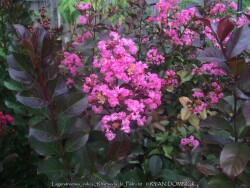

Crapemyrtle (Lagerstroemia) is a beautiful summer flowering shrub that dies down to the ground as a perennial each year in Zone 6 Kansas. Flower colors include bright red, pink, magenta, purple, and white. Many cultivars have been released improving foliage color, disease resistance, and flower blooming length. Newer cultivars now have maroon or reddish foliage adding interest before blooming. Beautiful fall color is often overlooked; shades of red, orange, and purple develop when Night temperatures reach into the 40s. In Kansas, crape myrtles grow best with hot south or west exposures or on south facing berms or hillsides. But they are suitable in any garden location as long as they are in full sun, they will build enough energy to come back from complete winter top-kill each year. Generally are 40 inches of rain per year is sufficient without extra watering, but if drought conditions occur, flowering will be reduced or shortened. Brief periods of excessive water and saturated soils are tolerated adding to their versatility. Many people from the south associate Crapemyrtles as a tree. That is true that in Texas and much of the Southeast, beautiful tree forms with exfoliating bark will occur because of mild winters. In Oklahoma and Arkansas for example crapemyrtles are usually grown as large shrubs experiencing major winterkill every 5-10 years. In Kansas and Missouri, or where temperatures regularly get to 0°, all top growth will die back and they will be grown as a woody perennial. After flowering and beautiful fall color is dropped, many people leave crapemyrtles throughout the winter to enjoy the winter interest of the dried seed heads. By March or April, cut plants close to the ground and watch for new growth. Flowering occurs on new wood and is much larger and more dramatic on sprouts from the ground. Flowers are often twice as big when grown this way. In the past, only fast-growing tree size cultivars for appropriate and Kansas because they have the ability to recover the fastest from complete winterkill and grow into a flowering-sized shrub by July. Now there are dwarf cultivars that are wood-hardy to -10 zone 6 for those not wanting to worry about winterkill. No disease or pest problems. Crapemyrtle are awesome for pollinators in the late season garden and especially effective when combined with vitex, butterfly bush, and/or caryopteris. Lagerstroemia indica 'Rhapsody in Pink' was developed by Dr. Carl Whitcomb. This upright growing shrub features light pink summer flowers appearing against handsome foliage, which emerges a purple hue that persists most of the season.


Prairie Blazing Star / Liatris, is also known as Liatris pycnostachya